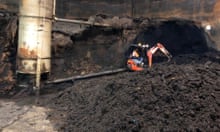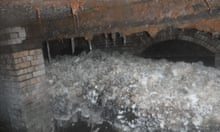Engineers are working around the clock to clear a “monster” fatberg 1km long which is clogging a sewer in Birmingham.
The blockage is not expected to be removed until June, water services company Severn Trent said in a statement, adding that the fatberg was about four miles east of the city centre, in Hodge Hill.
The mass is thought to weigh about 300 tonnes – equivalent to 250 cars. The water services company was alerted to the stoppage after its sensors detected rising water levels in the sewer.
Fatbergs are formed when oil, grease and fat poured down drains combine with non-biodegradable items such as wet wipes, nappies and cotton buds. A previous study revealed that cooking oil is the main contributor, making up nearly 90% of the mass.
Severn Trent urged people to be careful about what they flush down toilets to avoid blockages. The company said over the past year it had been alerted to thousands of blockages across the region, three-quarters of which had been caused by people misusing the sewer system.
Scott Burgin, Severn Trent operations manager, said: “Our advice is to always leave leftover cooking fat to cool before disposing of it in the bin and to stick to only flushing the three Ps (pee, poo and toilet paper) and bin anything else.
“These relatively small changes can make a big difference and hopefully avoid any future fatbergs.”
It is the latest in a series of fatbergs to have been cleared in recent years. One the size of an African elephant was broken up in October 2020. Thames Water removed 140 tonnes of fatbergs from the drains of Greenwich, Pall Mall and the Shard in 2019.
Water providers have launched campaigns to combat the waste issue, which is largely caused by incorrect disposal of non-biodegradable items. Thames Water’s “Bin it, don’t block it” campaign says the company is forced to remove about 75,000 blockages from sewers each year.
If left uncleared, the blockages can block pipes and push raw sewage back up drains, plugs and toilets. Thames Water says it removes 30 tonnes of “unflushable” material from one of its sites every day.
Fatbergs, which are partly a result of the UK’s plastic crisis, have been found to contain potentially deadly antibiotic-resistant bacteria. Experts have said the bacteria not only poses an immediate risk to operatives who work in sewers, but also to the public in the event of flooding caused by a blockage.








